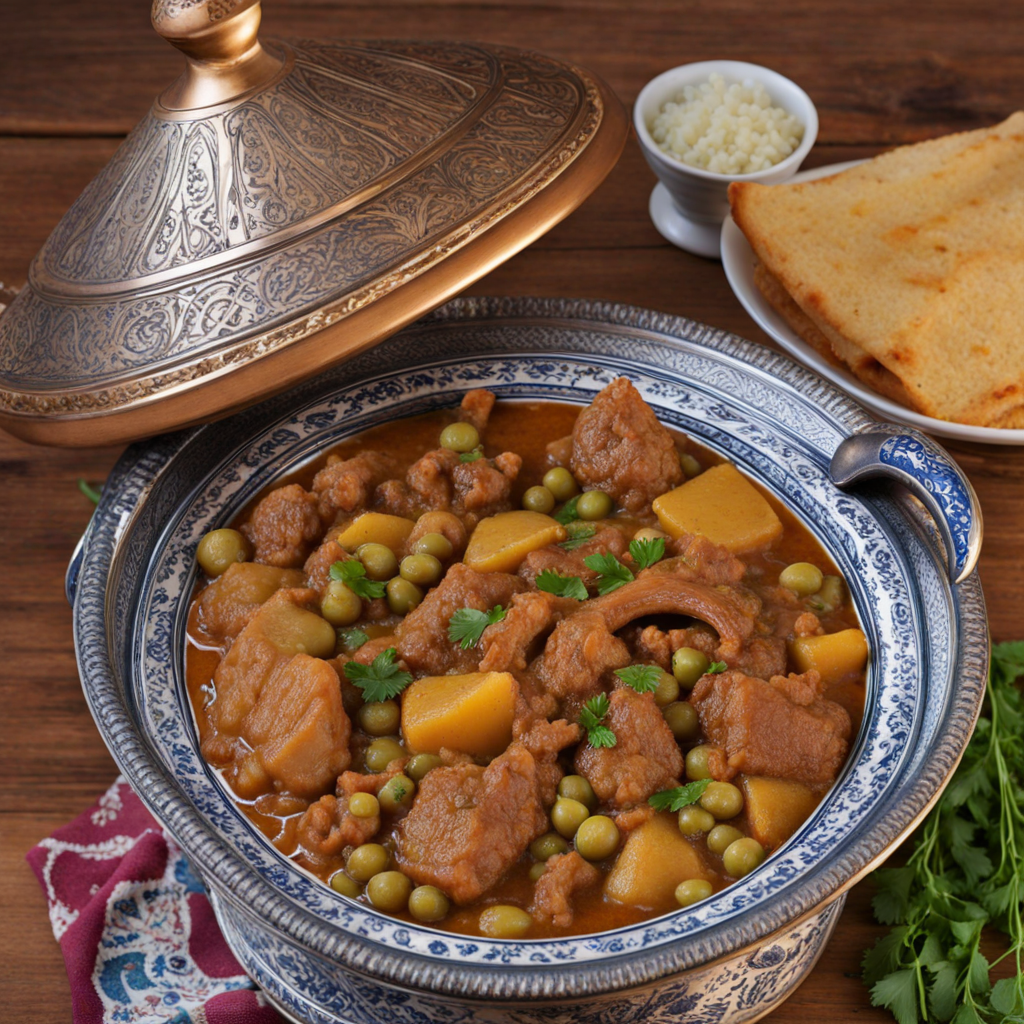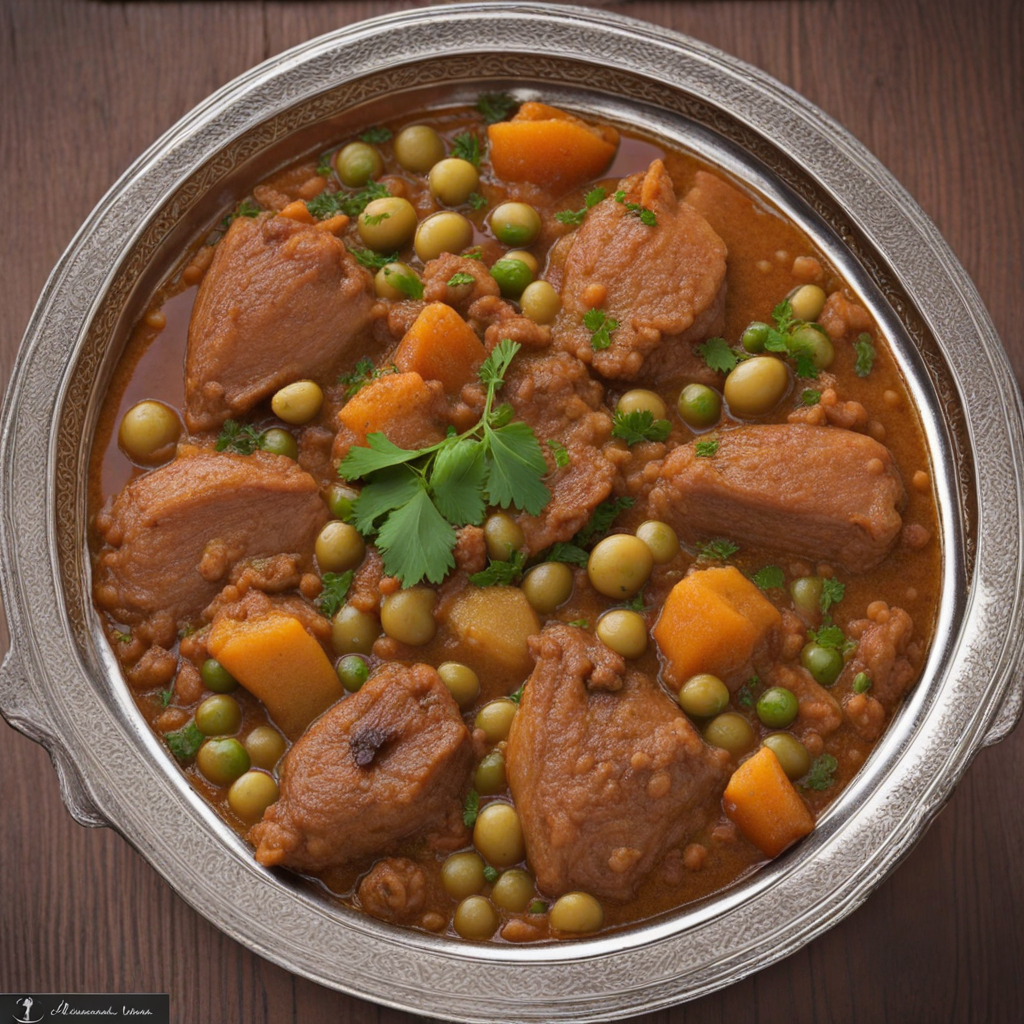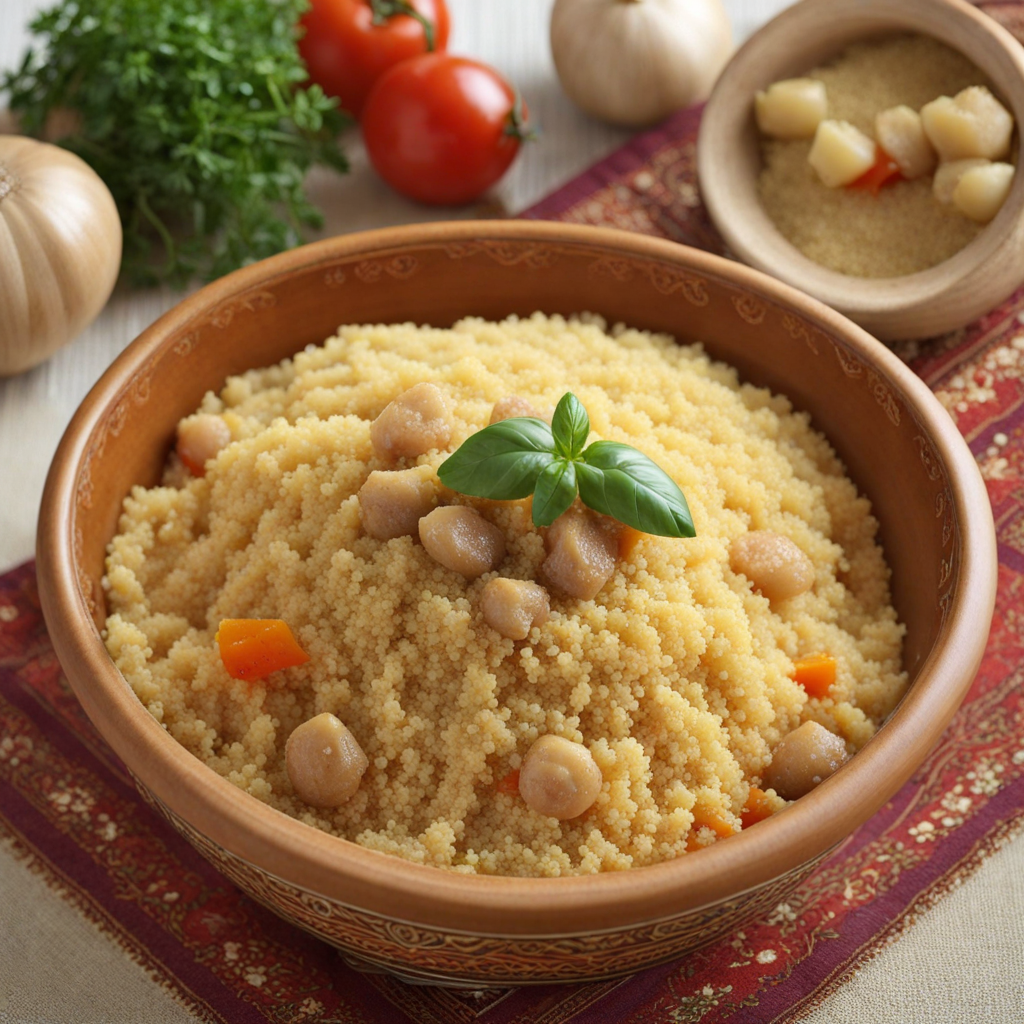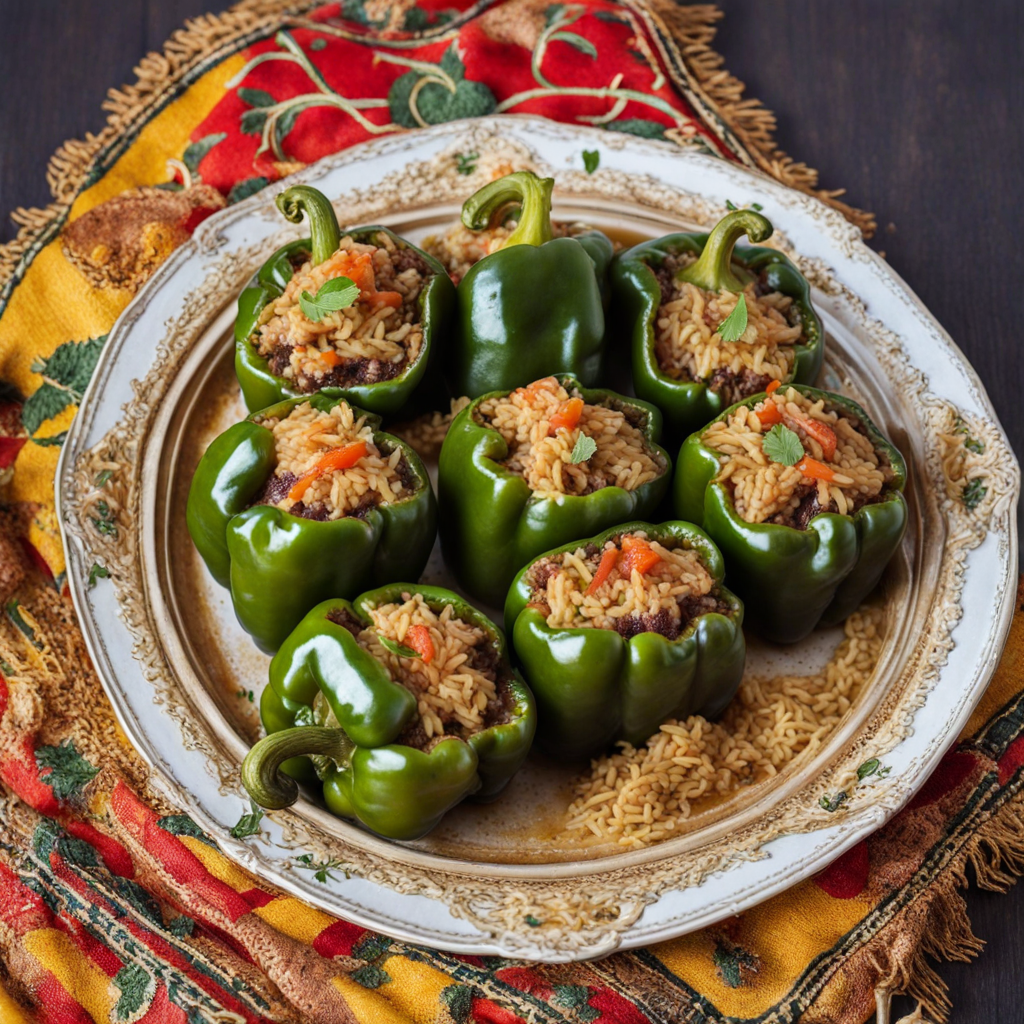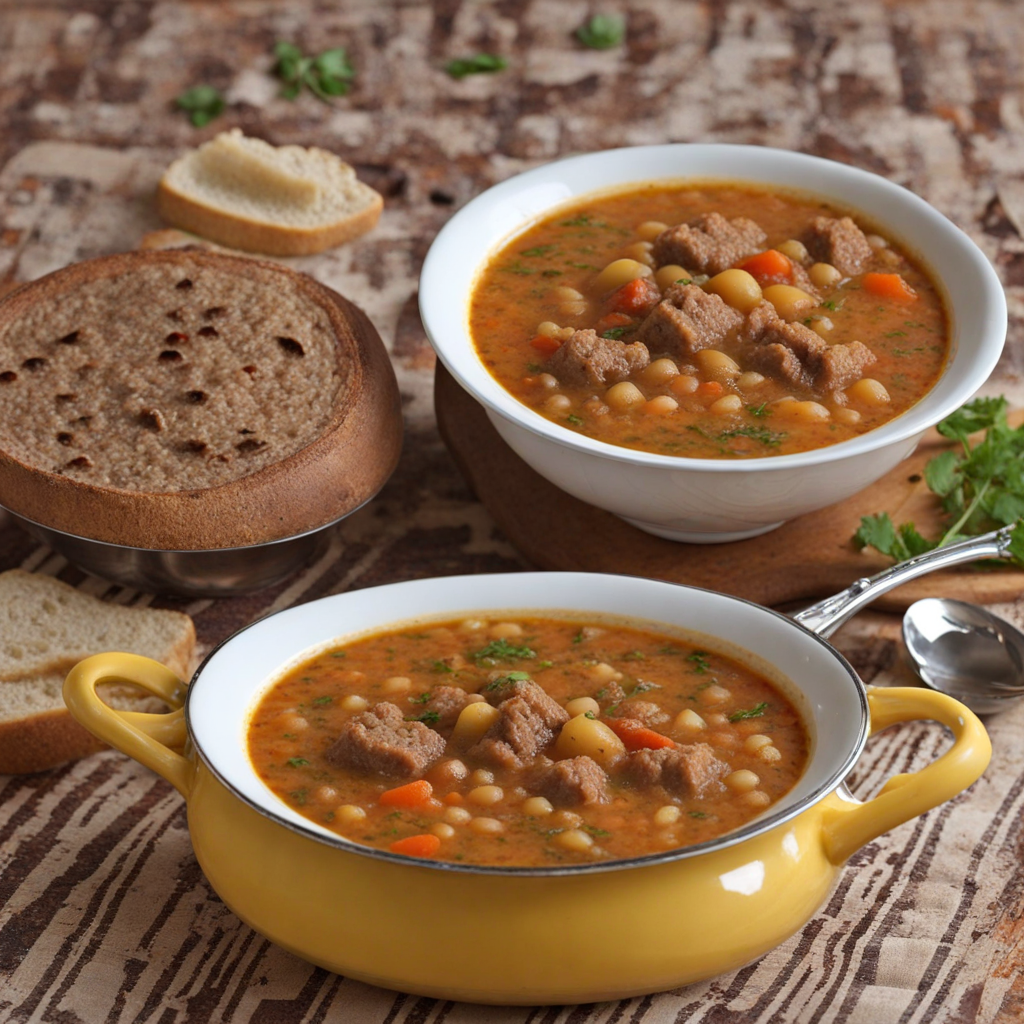Tajine Jelbana
Tajine Jelbana is a quintessential dish from Algeria, renowned for its rich and aromatic flavors that embody the essence of North African cuisine. This dish primarily features tender pieces of meat, often lamb or chicken, slow-cooked with a variety of fresh vegetables including carrots, potatoes, and peas. The unique blend of spices, such as cumin, coriander, and saffron, infuses the ingredients with a warm and inviting aroma that tantalizes the senses. The use of preserved lemons adds a zesty brightness, balancing the savory elements beautifully and enhancing the dish's overall complexity. What sets Tajine Jelbana apart is its cooking method, typically prepared in a traditional earthenware pot called a 'tajine.' This method allows the flavors to meld together as the ingredients gently simmer, resulting in a tender, melt-in-your-mouth experience. The dish is often served with a side of crusty bread or fluffy couscous, which perfectly soaks up the rich sauce, making each bite a delightful explosion of taste. The presentation is also a feast for the eyes, as the vibrant colors of the vegetables contrast beautifully with the succulent meat. As you savor Tajine Jelbana, you will find that it is not just a meal, but a celebration of culture and tradition. Each forkful tells a story of Algerian heritage, reflecting the communal spirit of sharing food with family and friends. Whether enjoyed during a festive gathering or a quiet family dinner, this dish encapsulates the warmth and hospitality that Algerian cuisine is known for, inviting you to explore the layers of flavor and the heartwarming experience it offers.
How It Became This Dish
The Culinary Heritage of طاجين جلبانة: A Journey Through Algeria’s Gastronomic Landscape Introduction Algeria, a vast country steeped in history and culture, boasts a rich culinary tradition that reflects its diverse influences, from Berber to Arab, Ottoman to French. Among its many dishes, طاجين جلبانة (Tajine Jelbana) stands out as a vibrant representation of Algerian food culture. This dish, primarily made with green peas, meat, and an array of spices, encapsulates the essence of Algeria's agricultural abundance and the intermingling of various culinary practices. Origins of طاجين جلبانة The term "tajine" originates from the Arabic word "ṭājīn," which refers to both the cooking vessel and the dish itself. Traditionally, tajines are slow-cooked stews prepared in earthenware pots, designed to retain moisture and enhance flavors. The roots of the tajine can be traced back to ancient North African civilizations, particularly the Berbers, who used clay pots to cook their meals. As the region evolved through various conquests and cultural exchanges, the tajine adapted to incorporate local ingredients and culinary techniques. طاجين جلبانة, specifically, reflects Algeria's agrarian lifestyle and the importance of seasonal produce. Green peas, one of the primary ingredients, flourish in Algeria's Mediterranean climate, making them a staple in local diets. The dish likely emerged as a way to highlight the freshness of these peas, particularly during the harvest season, when they are at their peak. Cultural Significance Food in Algeria is not merely sustenance; it is a vital part of social gatherings, celebrations, and familial bonds. طاجين جلبانة, like many traditional dishes, is often prepared for communal meals, symbolizing hospitality and togetherness. The act of sharing food is deeply embedded in Algerian culture, where meals serve as a medium for storytelling, tradition, and social interaction. The dish also carries historical significance, as it reflects the agricultural practices of the region. In rural areas, families often grow their own vegetables, and communal farming is a way of life. The use of locally sourced ingredients in طاجين جلبانة underscores the connection between the people and the land, celebrating the bounty of nature. In addition, the dish exemplifies the blending of culinary influences that characterize Algerian cuisine. The Ottomans, who ruled over Algeria for several centuries, introduced various spices and cooking techniques that enriched local dishes. The infusion of spices such as cumin, coriander, and cinnamon into طاجين جلبانة showcases this historical interplay, transforming a simple stew into a complex, flavorful experience. Development Over Time As Algeria underwent significant political and social changes throughout the 20th century, so too did its culinary landscape. With the rise of nationalism and the quest for cultural identity, Algerians began to embrace their culinary heritage more vigorously. Traditional dishes like طاجين جلبانة gained renewed appreciation as symbols of national pride. The post-independence era saw a revival of traditional cooking methods, with many families seeking to preserve their culinary heritage. This revival included the exploration of regional variations of طاجين جلبانة. While the basic ingredients remain consistent, different regions in Algeria may add unique elements. For instance, in coastal areas, seafood may be incorporated, while in the mountainous regions, game meat could be used, reflecting the local availability of ingredients. The globalization of food culture has also influenced طاجين جلبانة. In recent years, as Algerian cuisine has gained international recognition, chefs and home cooks alike have experimented with the dish, infusing it with modern techniques and fusion flavors. This evolution has led to a wider appreciation for the dish beyond Algeria's borders, allowing it to be showcased at culinary festivals and in restaurants around the world. Modern Interpretations Today, طاجين جلبانة is celebrated not only as a traditional dish but also as a canvas for culinary creativity. Chefs are reimagining the classic recipe, incorporating non-traditional ingredients or presenting it in innovative ways. For example, the use of quinoa or other grains as a base, alongside the traditional stewed meat and peas, speaks to contemporary dietary preferences and the global trend towards health-conscious eating. Moreover, the dish is often featured in Algerian homes during special occasions, such as weddings and religious celebrations. Its preparation is seen as a labor of love, often involving family members working together to create a meal that honors their heritage. This communal aspect of cooking and eating remains a cornerstone of Algerian culture, reinforcing the importance of family and tradition. Conclusion In essence, طاجين جلبانة is more than a culinary delight; it is a historical narrative woven into the fabric of Algerian society. Its origins reflect the agricultural richness of the land, while its cultural significance underscores the values of community and hospitality. As Algeria continues to navigate its identity in a rapidly changing world, dishes like طاجين جلبانة serve as a reminder of the past, a celebration of the present, and a bridge to the future. The journey of طاجين جلبانة is one of adaptation, resilience, and creativity, illustrating how food can transcend mere nourishment to become a powerful symbol of cultural identity. As diners savor the flavors of this traditional dish, they partake in a rich tapestry of history, culture, and community that is uniquely Algerian.
You may like
Discover local flavors from Algeria


